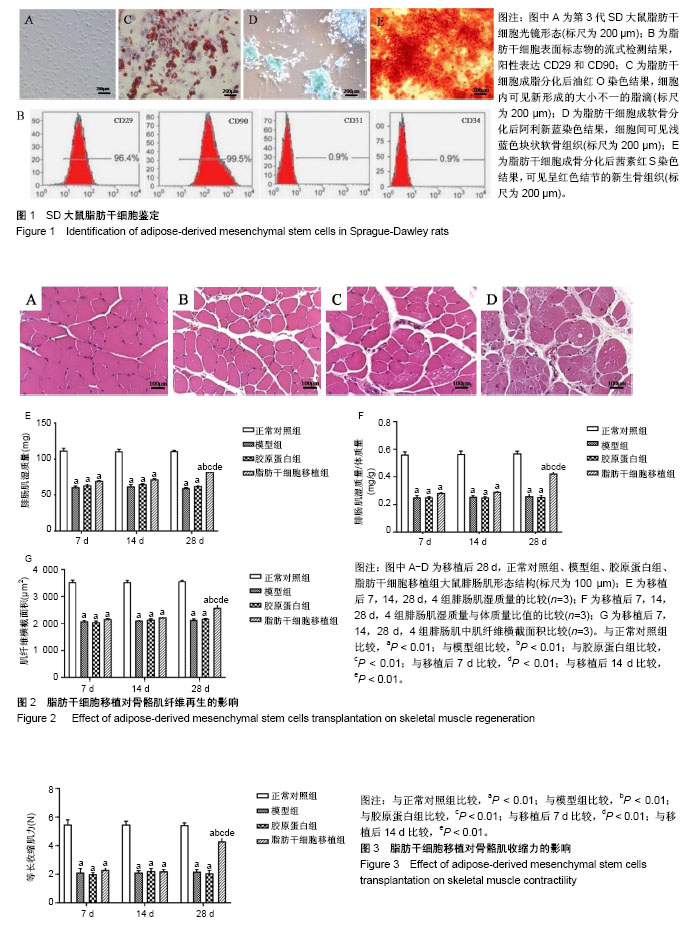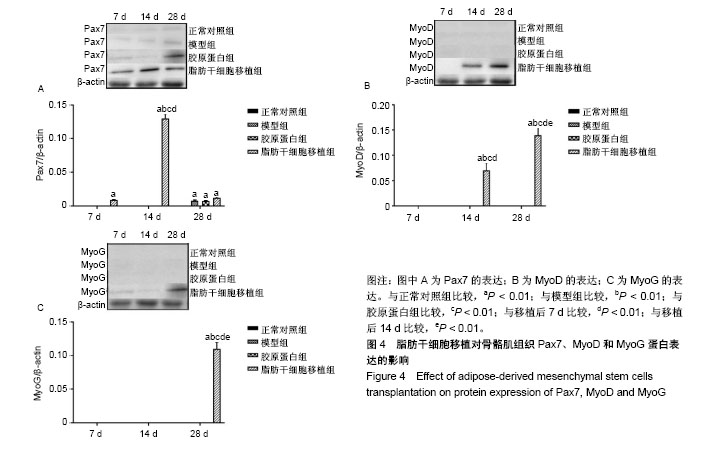| [1] Klimczak A, Kozlowska U, Kurpisz M. Muscle Stem/Progenitor Cells and Mesenchymal Stem Cells of Bone Marrow Origin for Skeletal Muscle Regeneration in Muscular Dystrophies. Arch Immunol Ther Exp (Warsz). 2018;66(5):341-354.[2] Costamagna D, Berardi E, Ceccarelli G, et al. Adult Stem Cells and Skeletal Muscle Regeneration. Curr Gene Ther. 2015;15(4):348-363.[3] Dumont NA, Bentzinger CF, Sincennes MC, et al. Satellite Cells and Skeletal Muscle Regeneration. Compr Physiol. 2015;5(3):1027-1059.[4] Marino S, Di Foggia V. Invited Review: Polycomb group genes in the regeneration of the healthy and pathological skeletal muscle. Neuropathol Appl Neurobiol. 2016;42(5):407-422.[5] Chazaud B. Inflammation during skeletal muscle regeneration and tissue remodeling: application to exercise-induced muscle damage management. Immunol Cell Biol. 2016;94(2):140-145.[6] Kozakowska M, Pietraszek-Gremplewicz K, Jozkowicz A, et al. The role of oxidative stress in skeletal muscle injury and regeneration: focus on antioxidant enzymes. J Muscle Res Cell Motil. 2015;36(6):377-393.[7] Bossola M, Marzetti E, Rosa F, et al. Skeletal muscle regeneration in cancer cachexia. Clin Exp Pharmacol Physiol. 2016;43(5):522-527.[8] Tu MK, Levin JB, Hamilton AM, et al. Calcium signaling in skeletal muscle development, maintenance and regeneration. Cell Calcium. 2016;59(2-3):91-97.[9] Almada AE, Wagers AJ. Molecular circuitry of stem cell fate in skeletal muscle regeneration, ageing and disease. Nat Rev Mol Cell Biol. 2016; 17(5):267-279.[10] Joanisse S, Nederveen JP, Snijders T, et al. Skeletal Muscle Regeneration, Repair and Remodelling in Aging: The Importance of Muscle Stem Cells and Vascularization. Gerontology. 2017;63(1):91-100.[11] Cruz-Martinez P, Pastor D, Estirado A, et al. Stem cell injection in the hindlimb skeletal muscle enhances neurorepair in mice with spinal cord injury. Regen Med. 2014;9(5):579-591.[12] Rahman MM, Ghosh M, Subramani J, et al. CD13 regulates anchorage and differentiation of the skeletal muscle satellite stem cell population in ischemic injury. Stem Cells. 2014;32(6):1564-1577.[13] Park JK, Ki MR, Lee EM, et al. Losartan improves adipose tissue-derived stem cell niche by inhibiting transforming growth factor-β and fibrosis in skeletal muscle injury. Cell Transplant. 2012;21(11):2407-2424.[14] Peçanha R, Bagno LL, Ribeiro MB, et al. Adipose-derived stem-cell treatment of skeletal muscle injury. J Bone Joint Surg Am. 2012; 94(7):609-617.[15] 王维,黄玉成,陈燕辉. 脂肪间充质干细胞对硬皮病小鼠皮损组织成纤维细胞增殖的影响及其机制[J].中国组织工程研究, 2018,22(33):5249-5254.[16] 张传辉,李建军,杨军.调控脂肪间充质干细胞成软骨分化基因 Sox-9和低氧诱导因子1α的表达[J].中国组织工程研究, 2016,20(45):6766-6773.[17] 杨记农,姜亦瑶,袁超,等.不同氧体积分数下脂肪间充质干细胞和脐带间充质干细胞的旁分泌能力[J].中国组织工程研究, 2018,22(21):3322-3327.[18] 罗翱,唐成林,黄思琴,等.骨骼肌急性钝挫伤修复过程中自噬相关因子的表达变化[J].中国应用生理学杂志, 2018,34(2):97-101,114.[19] 池凯,毋磊,陈龙金,等.人脱细胞真皮复合骨髓间充质干细胞构建组织工程皮肤修复皮肤创面缺损[J].中国组织工程研究, 2018,22(26):4179-4183.[20] 林小娟,唐毅,陈建豪,等. 脂肪干细胞移植对大鼠脑缺血后微血管生成及MT1-MMP表达的影响[J].中国实用神经疾病杂志, 2018,21(14): 1514-1520.[21] 王杨文洁,刘肇杰,安惠暄,等. 4周有氧运动介导apelin对小鼠骨骼肌UCP3表达的影响[J].中国运动医学杂志, 2018,37(9):772-777.[22] 张昕,李志清. 跑台运动训练对大鼠腓肠肌结构及最大收缩张力的影响[J]. 西北大学学报(自然科学版),2013,43(1):70-74.[23] Winkler T, von Roth P, Matziolis G, et al. Dose-response relationship of mesenchymal stem cell transplantation and functional regeneration after severe skeletal muscle injury in rats. Tissue Eng Part A. 2009;15(3): 487-492.[24] Ren Y, Wu H, Ma Y, et al. Potential of adipose-derived mesenchymal stem cells and skeletal muscle-derived satellite cells for somatic cell nuclear transfer mediated transgenesis in Arbas Cashmere goats. PLoS One. 2014;9(4):e93583.[25] Lee EM, Kim AY, Lee EJ, et al. Therapeutic effects of mouse adipose-derived stem cells and losartan in the skeletal muscle of injured mdx mice. Cell Transplant. 2015;24(5):939-953.[26] Rybalko V, Hsieh PL, Ricles LM, et al. Therapeutic potential of adipose-derived stem cells and macrophages for ischemic skeletal muscle repair. Regen Med. 2017;12(2):153-167.[27] Pinheiro CH, de Queiroz JC, Guimarães-Ferreira L, et al. Local injections of adipose-derived mesenchymal stem cells modulate inflammation and increase angiogenesis ameliorating the dystrophic phenotype in dystrophin-deficient skeletal muscle. Stem Cell Rev. 2012;8(2):363-374.[28] Mizuno H. The potential for treatment of skeletal muscle disorders with adipose-derived stem cells. Curr Stem Cell Res Ther. 2010;5(2):133-136.[29] Gorecka A, Salemi S, Haralampieva D, et al. Autologous transplantation of adipose-derived stem cells improves functional recovery of skeletal muscle without direct participation in new myofiber formation. Stem Cell Res Ther. 2018;9(1):195.[30] Crist C. Emerging new tools to study and treat muscle pathologies: genetics and molecular mechanisms underlying skeletal muscle development, regeneration, and disease. J Pathol. 2017;241(2):264-272.[31] Dueweke JJ, Awan TM, Mendias CL. Regeneration of Skeletal Muscle After Eccentric Injury. J Sport Rehabil. 2017;26(2):171-179.[32] Delaney K, Kasprzycka P, Ciemerych MA, et al. The role of TGF-β1 during skeletal muscle regeneration. Cell Biol Int. 2017;41(7):706-715.[33] Gonçalves TJM, Armand AS. Non-coding RNAs in skeletal muscle regeneration. Noncoding RNA Res. 2017;2(1):56-67.[34] Ultimo S, Zauli G, Martelli AM, et al. Influence of physical exercise on microRNAs in skeletal muscle regeneration, aging and diseases. Oncotarget. 2018;9(24):17220-17237.[35] Baghdadi MB, Tajbakhsh S. Regulation and phylogeny of skeletal muscle regeneration. Dev Biol. 2018;433(2):200-209.[36] Saba JD, de la Garza-Rodea AS. S1P lyase in skeletal muscle regeneration and satellite cell activation: exposing the hidden lyase. Biochim Biophys Acta. 2013;1831(1):167-175.[37] Ryall JG. Metabolic reprogramming as a novel regulator of skeletal muscle development and regeneration. FEBS J. 2013;280(17): 4004-4013.[38] Juban G, Chazaud B. Metabolic regulation of macrophages during tissue repair: insights from skeletal muscle regeneration. FEBS Lett. 2017; 591(19):3007-3021. |
.jpg)


.jpg)
.jpg)